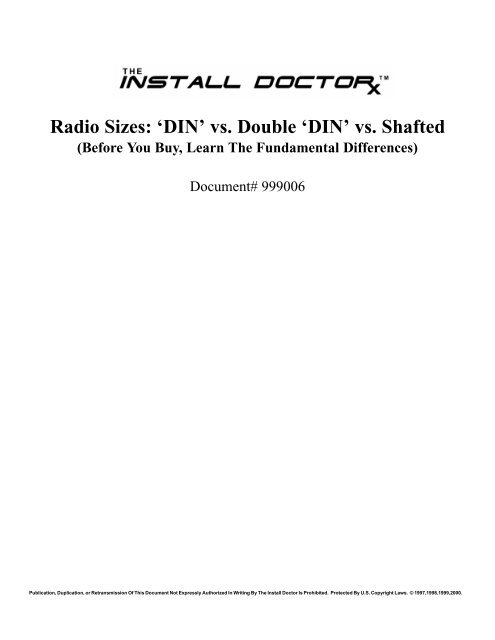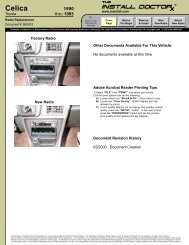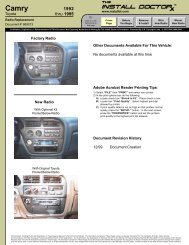999006- DIN vs Double DIN vs Shafted Radios - The Install Doctor
999006- DIN vs Double DIN vs Shafted Radios - The Install Doctor
999006- DIN vs Double DIN vs Shafted Radios - The Install Doctor
You also want an ePaper? Increase the reach of your titles
YUMPU automatically turns print PDFs into web optimized ePapers that Google loves.
Radio Sizes: ‘<strong>DIN</strong>’ <strong>vs</strong>. <strong>Double</strong> ‘<strong>DIN</strong>’ <strong>vs</strong>. <strong>Shafted</strong><br />
(Before You Buy, Learn <strong>The</strong> Fundamental Differences)<br />
Document# <strong>999006</strong><br />
Publication, Duplication, or Retransmission Of This Document Not Expressly Authorized In Writing By <strong>The</strong> <strong>Install</strong> <strong>Doctor</strong> Is Prohibited. Protected By U.S. Copyright Laws. © 1997,1998,1999,2000.
A Look At All 3 Radio Body Styles.<br />
Radio Face<br />
Plate<br />
Radio Body<br />
Radio Body<br />
<strong>Shafted</strong> Radio ‘<strong>DIN</strong>’ Radio <strong>Double</strong> ‘<strong>DIN</strong>’ Radio<br />
For additional information on similar topics, please consult the following technical documents:<br />
999005 Why Use Radio <strong>Install</strong>ation Kits (Why Do-It-Yourself <strong>Install</strong>s Look Amateur - Do It Like <strong>The</strong> Pros)<br />
999007 Mounting Your New Radio To An Indash <strong>Install</strong>ation Kit<br />
999010 Radio Security (How To Stay One Step Ahead Of Thieves)<br />
<strong>The</strong> Auto Makers Factory Radio Is Bigger Than This Radio. What’s Going On?<br />
When shopping for a new replacement radio for your vehicle, depending upon the make and model, you may quickly notice that new<br />
radios are different in size than the radio that was installed by the auto maker at the factory. What do you do?<br />
<strong>The</strong> car audio market has taken care of this for you. A vehicle owner shopping for a new radio will have many choices to choose from<br />
such as CD players, cassette players, cost <strong>vs</strong>. performance, detachable face, as well as brand preference. Now there are choices as well<br />
the buyer will have to make regarding the size of the new radio.<br />
To standardize the design and manufacturing of new replacement radios, car audio or more specifically car stereo manufacturers have<br />
begun to design and produce radios around the ‘<strong>DIN</strong>’ radio body style. This ‘<strong>DIN</strong>’ radio body style is rectangular (2” high x 7” wide)<br />
which can be adapted to virtually every vehicle produced today. One offshoot of this body style called the <strong>Double</strong> ‘<strong>DIN</strong>’ radio body<br />
style (4” high x 7” wide) is designed to fit certain auto makers radio dash openings which use a larger radio or a combination of radio<br />
above a pocket or tray. To understand a little more about these ‘<strong>DIN</strong>’ radio body styles we need to take a trip to the past and look at a<br />
third body style, the original car stereo body style, the “shafted” radio.<br />
<strong>The</strong> Car Stereo Your Parents Listened To.<br />
‘<strong>DIN</strong>’ Radio Sleeve<br />
Up until the mid to late 1980’s, the standard car stereo found in many vehicles was the “shafted” radio. Before the days of digital<br />
displays and digital tuning were the days of analog radios which required someone to turn a knob to tune to their favorite radio stations.<br />
<strong>The</strong> “shafted” radio is designed with a knob on the left, usually to turn the radio on and to control volume, and a knob on the right to<br />
tune the radio stations. In the middle was the radios display box where you might find an old 8-track tape or the state of the art (at that<br />
time) audio cassette tape.<br />
<strong>The</strong> “shafted” radio has seen many changes: the addition of digital clocks, digital tuning, digital displays and other cosmetic changes.<br />
But, this body style just would not allow a CD to inserted. This was the death of the “shafted” radio. <strong>Shafted</strong> radios also had another<br />
drawback: many times they were too hard to remove and install. Due to the design of “shafted” radios these radios required them to be<br />
installed from the rear of the dash. This also meant that they had to be removed in reverse direction, usually requiring the removal of<br />
lower dash panels, air conditioner ducting, all while trying to keep your hands from being cut and scraped by the metal and hard<br />
plastics auto makers designed their dashes with. With the advent of CD players and the publics desire to listen to CD’s in their vehicle,<br />
the ‘<strong>DIN</strong>’ body style of radio began to claim a stake in the car audio market. As this happened, car stereo installers were forced to<br />
modify a customers vehicle to accept this new ‘<strong>DIN</strong>’ body style. In order to do this, a vehicles dash had to be cut to allow the<br />
2” high x 7” wide ‘<strong>DIN</strong>’ radio to slide into the dash from the front.<br />
Eventually, auto makers saw the need to design dashes and new radios to allow the use of CD’s in their factory radios. As this began to<br />
happen, the shafted radio quickly decreased in popularity. <strong>Shafted</strong> radios are still available, but are almost exclusively sold as entry<br />
level radios.
Selecting <strong>The</strong>n <strong>Install</strong>ing A New Radio. What You Need To Know.<br />
<strong>Shafted</strong> <strong>Radios</strong>: <strong>Shafted</strong> radios purchased for vehicles made after the mid to late 1980’s will most likely need an indash<br />
radio installation kit. Unless that vehicle originally had a shafted radio installed by the auto maker the shafted radio will not<br />
fit into the vehicles dash unless it has something to mount to. <strong>Shafted</strong> radios are designed to mount to a dash by securing the<br />
shafts of the radio itself. Most modern vehicles will leave a square or rectangular opening in the dash preventing a shafted<br />
radio from being installed. An indash installation kit can be purchased that will adapt that particular vehicles dash to accept a<br />
shafted radio. <strong>The</strong> shafted radio will mount to the kit, and the kit can then be mounted to the dash of the vehicle.<br />
Note: when selecting a shafted radio, make sure that you understand the cost of adding an indash radio installation<br />
kit. If the cost of the radio is an issue, many times the cost of adding the installation kit will allow the buyer to<br />
upgrade to a ‘<strong>DIN</strong>’ radio which may not require the use of an installation kit (depending upon the vehicle).<br />
‘<strong>DIN</strong>’ <strong>Radios</strong>: This radio style can be installed relatively easily in the majority of vehicles produced today. For some<br />
vehicles, ‘<strong>DIN</strong>’ radios are direct replacements for the auto makers factory radio requiring no indash installation kit in order to<br />
mount it to the dash of the vehicle.<br />
Other automobiles which use a larger size radio from the auto maker will require an indash installation kit in order to mount a<br />
‘<strong>DIN</strong>’ radio to the vehicle. Hundreds of kits are available for virtually every vehicle made. Since every vehicle is different,<br />
each kit will vary from every other kit. When selecting a new replacement radio, for vehicles with larger radios installed<br />
from the auto maker, make sure to factor in the cost of an installation kit.<br />
For vehicles where the auto maker used a ‘<strong>DIN</strong>’ sized radio, an indash installation kit may or may not be needed. <strong>The</strong>re are<br />
some auto makers that combine a ‘<strong>DIN</strong>’ style radio to a pocket or tray located below the radio. <strong>The</strong>se vehicles pose an<br />
interesting decision for the owner of the vehicle. Some auto makers (Nissan, Toyota, and others) attach the their factory<br />
‘<strong>DIN</strong>’ radios to the pocket below the radio by using side brackets which simply unscrew from the side of the radio. For these<br />
vehicles, a new replacement ‘<strong>DIN</strong>’ radio, if designed with this option (see NOTE below), can accept the bracket and pocket.<br />
This is called “ISO” mounting the radio. In other words, the new replacement radio is truly a direct replacement for the auto<br />
makers factory radio. <strong>The</strong> auto makers original radio simply unscrews from the side brackets and pocket below the radio, and<br />
the new replacement ‘<strong>DIN</strong>’ radio slides in and even uses the same screws. A decision? <strong>The</strong> vehicles owner will have a<br />
decision to “ISO” mount the radio, or use an indash installation kit. When removing the factory radio and attached pocket or<br />
tray, the owner or installer may decide to use an installation kit to mount the radio to the dash of the vehicle instead of the<br />
“ISO” mounting method. <strong>The</strong> <strong>Install</strong> <strong>Doctor</strong> recommend using the “ISO” mounting method when possible. This “ISO”<br />
method is a more secure method to mount the new replacement radio, plus it allow the vehicles owner to keep the pocket or<br />
tray below the radio as well as having to add on the cost of the installation kit. An installation kit, unless designed with a<br />
pocket, will cover the space with plastic.<br />
Note: not all ‘<strong>DIN</strong>’ style radios can be “ISO” mounted. In order for a new ‘<strong>DIN</strong>’ radio to be<br />
“ISO” mounted, the trim ring which surrounds the face of the radio must be able to be removed.<br />
When “ISO” mounting a radio, the trim ring is removed and the radio is installed without the trim<br />
ring. “ISO” mounting a radio mounts the radio and bracket to the dash BEHIND the dash panel<br />
which covers the radio opening. If the trim ring of the new “<strong>DIN</strong>” radio is left on, the dash<br />
panel will hit the trim ring and not reinstall properly to the dash. To prevent this, some but NOT<br />
Trim Ring “ISO” mount<br />
screw holes<br />
ALL stereo makers design their “<strong>DIN</strong>” radios with the trim ring removable. When selecting a<br />
new replacement ‘<strong>DIN</strong>’ style radio, make sure the trim ring removes from the radio.<br />
<strong>Double</strong> ‘<strong>DIN</strong>’ <strong>Radios</strong>: This body style is usually only available for certain auto makers factory radios. <strong>The</strong>se double ‘<strong>DIN</strong>’<br />
sized radios are designed as a replacement to auto makers radios that are oversized or used a ‘<strong>DIN</strong>’ radio attached to a pocket<br />
or tray. Before selecting a double ‘<strong>DIN</strong>’ radio, you might want to check with an installer in your area to verify it will fit your<br />
particular vehicle. <strong>The</strong> <strong>Install</strong> <strong>Doctor</strong> views double ‘<strong>DIN</strong>’ radios as more gimmick than anything else. Most double ‘<strong>DIN</strong>’<br />
radios simply add fancy graphics displays without adding any real value to the radios performance. <strong>The</strong> <strong>Install</strong> <strong>Doctor</strong><br />
recommends using a standard ‘<strong>DIN</strong>’ sized radio installed with an installation kit or installed using the “ISO” mounting<br />
method described above.












